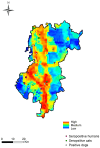Raising Awareness of Canine, Feline and Human Dirofilariosis in Aveiro, Portugal: A One Health Perspective
- PMID: 40218346
- PMCID: PMC11988007
- DOI: 10.3390/ani15070952
Raising Awareness of Canine, Feline and Human Dirofilariosis in Aveiro, Portugal: A One Health Perspective
Abstract
Climatic and various socio-geographical variables have significantly influenced the global spread of Dirofilaria immitis. The coastal district of Aveiro, Portugal, marked by its unique hydrographic structure, Ria de Aveiro, and a concerning rise in heartworm disease, was the focus of our study. We aimed to update the prevalence of D. immitis in dogs and the seroprevalence in cats and humans, correlating these data with epidemiological information. A total of 430 dogs were sampled for D. immitis antigens, and 426 cats and 398 humans for D. immitis and Wolbachia sp. antibodies. In addition, we developed and validated an infection risk map for D. immitis with the geolocation of positive samples. Our results indicate a canine prevalence of 4.7%, peaking at 16.7% in Vagos. Feline and human seroprevalences were 8.9% (26.7% in Espinho) and 3.0% (Vagos presented the most alarming results), respectively. Positive samples were found in both high- and low-risk areas highlighting the need for chemoprophylaxis in all municipalities. Risk factors identified included lack of vaccination and internal deworming in cats, while dogs faced risks from inadequate vaccination and outdoor exposure. Our study identifies Aveiro as an endemic area, with a need for control measures to address this public health threat.
Keywords: Aveiro; Dirofilaria immitis; Portugal; Wolbachia pipientis; seroepidemiological study; zoonosis.
Conflict of interest statement
The authors declare no conflicts of interest.
Figures
Similar articles
-
Seroprevalence of heartworm (Dirofilaria immitis) in feline and canine hosts from central and northern Portugal.J Helminthol. 2015 Sep;89(5):625-9. doi: 10.1017/S0022149X14000352. Epub 2014 May 14. J Helminthol. 2015. PMID: 24824176
-
The impact of the climate on the epidemiology of Dirofilaria immitis in the pet population of the Canary Islands.Vet Parasitol. 2016 Jan 30;216:66-71. doi: 10.1016/j.vetpar.2015.12.005. Epub 2015 Dec 15. Vet Parasitol. 2016. PMID: 26801597
-
Prevalence of heartworm in dogs and cats of Madrid, Spain.Parasit Vectors. 2017 Jul 26;10(1):354. doi: 10.1186/s13071-017-2299-x. Parasit Vectors. 2017. PMID: 28747221 Free PMC article.
-
The prevalence of Dirofilaria immitis and D. repens in the Old World.Vet Parasitol. 2020 Apr;280:108995. doi: 10.1016/j.vetpar.2019.108995. Epub 2019 Nov 21. Vet Parasitol. 2020. PMID: 32155518 Review.
-
Dirofilariosis in the Americas: a more virulent Dirofilaria immitis?Parasit Vectors. 2013 Oct 2;6(1):288. doi: 10.1186/1756-3305-6-288. Parasit Vectors. 2013. PMID: 24274042 Free PMC article. Review.
References
-
- Morchon R., Ferreira A.C., Martin-Pacho J.R., Montoya A., Mortarino M., Genchi C., Simon F. Specific IgG antibody response against antigens of Dirofilaria immitis and its Wolbachia endosymbiont bacterium in cats with natural and experimental infections. Vet. Parasitol. 2004;125:313–321. doi: 10.1016/j.vetpar.2004.08.003. - DOI - PubMed
Grants and funding
LinkOut - more resources
Full Text Sources
Miscellaneous



